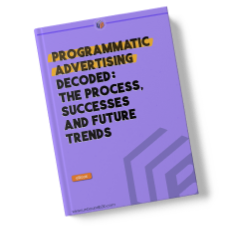
Programmatic Account-Based Marketing (ABM) is changing the way companies target high-value accounts on a large scale with efficiency. It is a data-driven strategy that matches marketing initiatives with revenue targets, thereby speeding growth and strengthening resource allocation for long-term success as marketers strive to stay ahead in a highly competitive environment.
A 2024 ABA survey report shows that companies using ABM achieve a conversion rate 60% higher than those who don’t. The report also shows a 72% increase in customer engagement with targeted advertising. These statistics highlight the advantages of ABM-driven advertising strategies.
As B2B SaaS companies face pressure to stand out in saturated markets, Programmatic ABM can be a game-changer. By combining automation with a customized marketing approach, Programmatic ABM gives impactful results. For example, after PayScale executed ABM to boost its marketing, it led to a 500% increase in engagement with target accounts and a 6x revenue growth in just seven months.
What is Programmatic ABM?
Programmatic ABM is a strategy that integrates the precision of ABM with the automation and targeting power of programmatic advertising. This approach allows businesses to focus their marketing efforts on specific high-value accounts by delivering personalized content and messages to the right decision-makers at the right time.
Unlike broader digital marketing, which targets a large audience, Programmatic ABM narrows the focus to individual accounts that closely align with a company’s ideal customer profile (ICP). It improves lead nurturing, generates demand, and increases brand recognition.
Programmatic advertising can scale businesses’ ABM efforts by reaching an increased number of targeted accounts while still maintaining personalization. It is an effective method to maximize the impact of ABM through automation and targeting benefits for greater engagement and outcomes in B2B companies.
Types of ABM
Account-Based Marketing (ABM) is a strategic business method that is employed to support marketing communication efforts in defined market segments. If employed correctly, ABM offers the unique advantage of creating value-added content and message that focuses on an account or a set of accounts to establish deeper, mutual connection and yield greater ROI. It has three major types:

- Strategic ABM: Also known as One-to-one ABM, Strategic ABM focuses on delivering highly targeted, personalized communication tailored to the specific requirements, challenges, and preferences of individual accounts. This approach is typically reserved for a company’s most critical and high-value accounts.
- ABM Lite: Also known as One-to-Few ABM, this approach targets a small group of similar accounts simultaneously, offering greater personalization compared to Large-Scale ABM. By grouping accounts with shared characteristics, marketers can craft tailored messages for each segment while expanding campaign reach through the use of automated and programmatic techniques.
- Programmatic ABM: Also known as One-to-Many ABM, Programmatic ABM leverages digital and automated communication to target a broad audience of accounts that align with the Ideal Customer Profile (ICP). This approach is the most scalable form of ABM, focusing on a large number of accounts. While it is less personalized compared to One-to-One and One-to-Few ABM, it remains an effective and essential strategy.
How Programmatic ABM Helps B2B Marketers
Programmatic ABM has proven to be a powerful strategy for B2B marketers, delivering measurable improvements across key metrics. One of the most significant benefits is its ability to increase pipeline opportunities and drive targeted lead generation.
For example, 65% of companies have reported an increase in pipeline opportunities with the help of ABM programs. They have also seen a lead growth of 64% with these programs.
Additionally, research by Gartner found that ABM can boost pipeline conversion rates for B2B marketers by up to 14%, with a 25% improvement in the conversion from marketing-qualified leads to sales-accepted leads.
Moreover, Programmatic ABM also helps the B2B companies to organize the sales cycle. By aligning marketing and sales teams and focusing on the most promising accounts, businesses can reduce the time spent on unproductive sales prospecting by up to 50%. This helps in shortening the sales cycle while also improving conversion rates and ROIs.
ABM is particularly useful for B2B marketers since it provides the opportunity to optimize cost per acquisition (CPA) by addressing abstract audiences with high-value accounts.
Real-time bidding is a strategy that offers useful mitigations that help in lowering CPA by correctly targeting the customer’s interest and improving conversion rates in programmatic ABM
By integrating advanced analytical tools like Leadfeeder, Clearbit and Hubspot amongst others with programmatic advertising, marketers can optimize campaigns, remain contextually appropriate and achieve lower acquisition costs.
Key Strategies for Implementing Programmatic ABM
- Identify Target Accounts: Use CRM data and enrichment tools to find and prioritize accounts that hold the most value.
- Segment for Precision: Organize accounts by industry or specific needs to customize messaging for each group.
- Develop Personalized Creatives: Personalize emails, landing pages, and visuals for each segment to ensure they relate to the data and information you are providing.
- Account Level Reporting: With Programmatic ABM, identify the accounts to which your ads being exposed track their engagement and move down those accounts to sales funnel
- Measure and Refine: Monitor conversions and engagement, adjusting campaigns based on real-time data and insights.
Five Key Benefits of Programmatic ABM
- Improved Precision and Personalization: Custom-designed ads capture attention, building stronger connections with targeted accounts and driving deeper engagement.
- Scalability and Efficiency: Automated outreach helps in growing personalized campaigns making it ideal for fast-growing B2B companies.
- Improved ROI: Focused targeting increases conversion rates and optimizes ad spend, resulting in higher and improved ROI.
- Sales and Marketing Alignment: Shared data improves coordination and better implementation of ABM strategies.
- Streamlined Buyer’s Journey: Consistent and relevant messaging nurtures leads at every stage, resulting in a shortened sales cycle.
Programmatic ABM: The Financial Picture
Programmatic ABM offers a lot of financial benefits. With continuous focused efforts on high-potential accounts, it generates higher engagement and conversion rates, thus delivering a better and improved ROI.
Industry spending is expected to grow as companies recognize the efficiency and cost-effectiveness of Programmatic ABM, a trend likely to continue in the coming years.
The scope of Programmatic ABM is rapidly increasing. According to a recent stat, programmatic ad spending reached approximately $157.35 billion in the first quarter of 2024 and is expected to grow to $178.25 billion by 2025. This reflects a 15.9% growth rate, with programmatic accounting for 91.3% of total ad spending.
If programmatic advertising sounds like the right fit for scaling your ABM efforts, our eBook dives deeper into how to make it work effectively for your business.

UnboundB2B’s Integration of ABM with Programmatic Advertising
Unbound Promote integrates Account-Based Marketing (ABM) with Programmatic Advertising, using intent data to create highly personalized, data-driven solutions for B2B businesses. The platform enhances brand visibility across multiple channels by consistently engaging with high-value accounts most likely to convert.
Additionally, its built-in lead scoring system effectively gauges buyer intent and interest levels, helping to boost conversion rates and streamline the sales process.
Consider Programmatic ABM, if your company seeks a scalable, data-centric approach that aligns marketing with revenue objectives. If your team values streamlined operations, personalized engagement, and a focused marketing strategy that maximizes impact. Programmatic ABM could be the catalyst for your company’s next phase of growth.
Our blog
Latest blog posts
Tool and strategies modern teams need to help their companies grow.

Personalization functions as the vital foundation for executing B2B marketing effecti...

Beat your competitors and exceed your revenue goals this year by shifting your focus ...

SaaS growth has never been more challenging. SaaS companies must move faster and smar...






